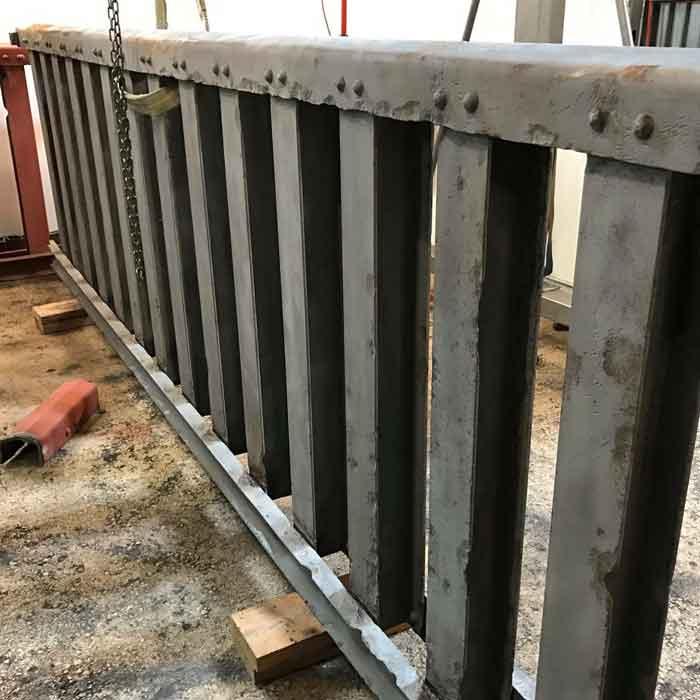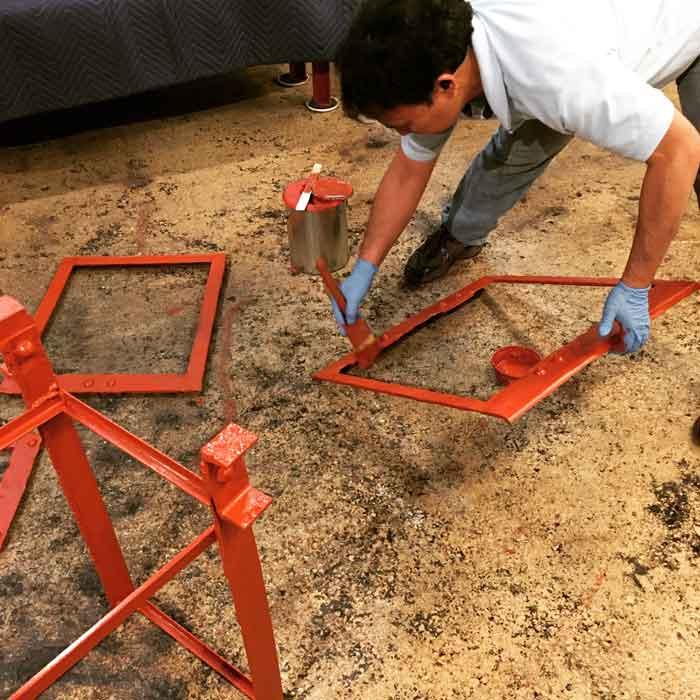- FMA
- The Fabricator
- FABTECH
- Canadian Metalworking
Categories
- Additive Manufacturing
- Aluminum Welding
- Arc Welding
- Assembly and Joining
- Automation and Robotics
- Bending and Forming
- Consumables
- Cutting and Weld Prep
- Electric Vehicles
- En Español
- Finishing
- Hydroforming
- Laser Cutting
- Laser Welding
- Machining
- Manufacturing Software
- Materials Handling
- Metals/Materials
- Oxyfuel Cutting
- Plasma Cutting
- Power Tools
- Punching and Other Holemaking
- Roll Forming
- Safety
- Sawing
- Shearing
- Shop Management
- Testing and Measuring
- Tube and Pipe Fabrication
- Tube and Pipe Production
- Waterjet Cutting
Industry Directory
Webcasts
Podcasts
FAB 40
Advertise
Subscribe
Account Login
Search
Turning Golden Gate Bridge handrails into home furnishing
California fabricator takes scrap metal from icon bridge to create functional pieces of history
- By Sue Roberts
- January 19, 2020
- Article
- Shop Management

Rick Bulan gives a second life to Golden Gate Bridge handrails by using the material to create artisan furniture and accessories.
A 1.7-mile-long, orange, cable suspension bridge links the northern tip of San Francisco’s peninsula and California’s Marin County. According to the Golden Gate Bridge Highway & Transportation District, it provides safe passage for more than 20 million vehicles a year—and that’s just southbound. Locals cross regularly and visitors travel to the area specifically to traverse the Golden Gate Bridge.
Nay-sayers said it couldn’t be built right up to the beginning of its construction in 1933. Today the bridge is part of both U.S. Route 101 and California State Route 1. It makes memories, steals hearts, is perhaps the most photographed bridge in the world, and often appears on lists of modern world wonders.
Replacement of some of its weathered handrails in 1993 was featured in a television news report that was seen by Rick Bulan, a San Francisco native whose daily transit over the bridge created an emotional connection.
“The history of the material and childhood memories spoke to me,” Bulan said. “I just wanted a piece of the bridge for myself and I thought that the steel would make a cool headboard.” He contacted the contractors and purchased his first 12½-ft.-long, 42-in.- tall, 1,000-lb. handrail.
Steel from the first handrail yielded four headboards. The extra three were quickly snapped up by friends who also wanted to own a functional piece of Golden Gate Bridge history. He purchased the remaining available handrails, established the Golden Gate Furniture Co., and began turning the steel into a line of unique furniture.
Coffee tables, executive desks, end tables, bookends, and even keychains and jewelry have joined the products list. All tout the bridge’s well-known International Orange color that was originally chosen to complement its natural surroundings.
From Handrails to Decor
Bulan develops the furniture concepts, creates 3D models using SketchUp software, and marks and cuts the steel all in his 500-sq.-ft. studio that is part of Hunters Point Shipyard Artists, an artist’s community housed in an old warehouse in southeastern San Francisco. About half of the 75 artists there also work with metal, so when Bulan’s work load warrants extra hands for welding or painting, he can call on his neighbors.
“When I started on the first piece, I didn’t know anything about welding or fabricating. I was using abrasive blades on a SKILSAW® to try to cut these girders. A neighbor introduced me to oxygen acetylene cutting and I taught myself how to do some basic welding. Eventually I attended an art welding class,” he said. “Now, in addition to my welding equipment, I have a hand-held plasma cutter, a couple of large band saws, and an army of grinders.”
The majority of the handrails are sandblasted before going into production and then repainted the bridge’s International Orange. But, on occasion, a customer prefers the old finish and is willing to accept some visible burnoff on the edges and exposed welding beads to maintain the patina.
Nothing goes to waste. All of the material, originally from Bethlehem Steel in Pennsylvania, is used.

Most bridge sections, like this handrail, are sandblasted before being cut to size for furniture and accessories.
“Suppose I start working with a section of a handrail by making a night table. The remaining steel might become a coffee table. Then there might be an inch or so of the cross-beam section left over. That turns into jewelry,” Bulan said.
Additional materials—like fossilized stone, salvaged wood, and glass—are sourced from the U.S. “Keeping with the spirit of the bridge, if I use any new steel it is U.S.-milled in Salt Lake City. Paint is from Sherwin-Williams in Sparks, Nev. Glass comes from North Carolina. Brass for the numbering plates on every piece of furniture is from Los Angeles and they are etched in Santa Cruz.”
Customization Is Standard
Variances in the original handrails demand some customization for every piece of furniture.
“All the metal work was done by hand when the bridge was built. From a distance it looks pretty uniform, but up close you see that the rivets don’t actually line up. On top of that, each section leans in one direction depending on where it was placed and the arch of the bridge. Distances between the pickets of the railing vary by ¼ to 1/2 in.,” Bulan said.
Bulan said that he’s not sure just how much Golden Gate Bridge steel is left, but the supply is dwindling. What happens when it’s gone? He said, “I’ll cross that bridge when I come to it.”
About the Author

subscribe now

The Fabricator is North America's leading magazine for the metal forming and fabricating industry. The magazine delivers the news, technical articles, and case histories that enable fabricators to do their jobs more efficiently. The Fabricator has served the industry since 1970.
start your free subscription- Stay connected from anywhere

Easily access valuable industry resources now with full access to the digital edition of The Fabricator.

Easily access valuable industry resources now with full access to the digital edition of The Welder.

Easily access valuable industry resources now with full access to the digital edition of The Tube and Pipe Journal.
- Podcasting
- Podcast:
- The Fabricator Podcast
- Published:
- 04/16/2024
- Running Time:
- 63:29
In this episode of The Fabricator Podcast, Caleb Chamberlain, co-founder and CEO of OSH Cut, discusses his company’s...
- Trending Articles
Tips for creating sheet metal tubes with perforations

Supporting the metal fabricating industry through FMA

JM Steel triples capacity for solar energy projects at Pennsylvania facility

Are two heads better than one in fiber laser cutting?

Fabricating favorite childhood memories

- Industry Events
16th Annual Safety Conference
- April 30 - May 1, 2024
- Elgin,
Pipe and Tube Conference
- May 21 - 22, 2024
- Omaha, NE
World-Class Roll Forming Workshop
- June 5 - 6, 2024
- Louisville, KY
Advanced Laser Application Workshop
- June 25 - 27, 2024
- Novi, MI



























